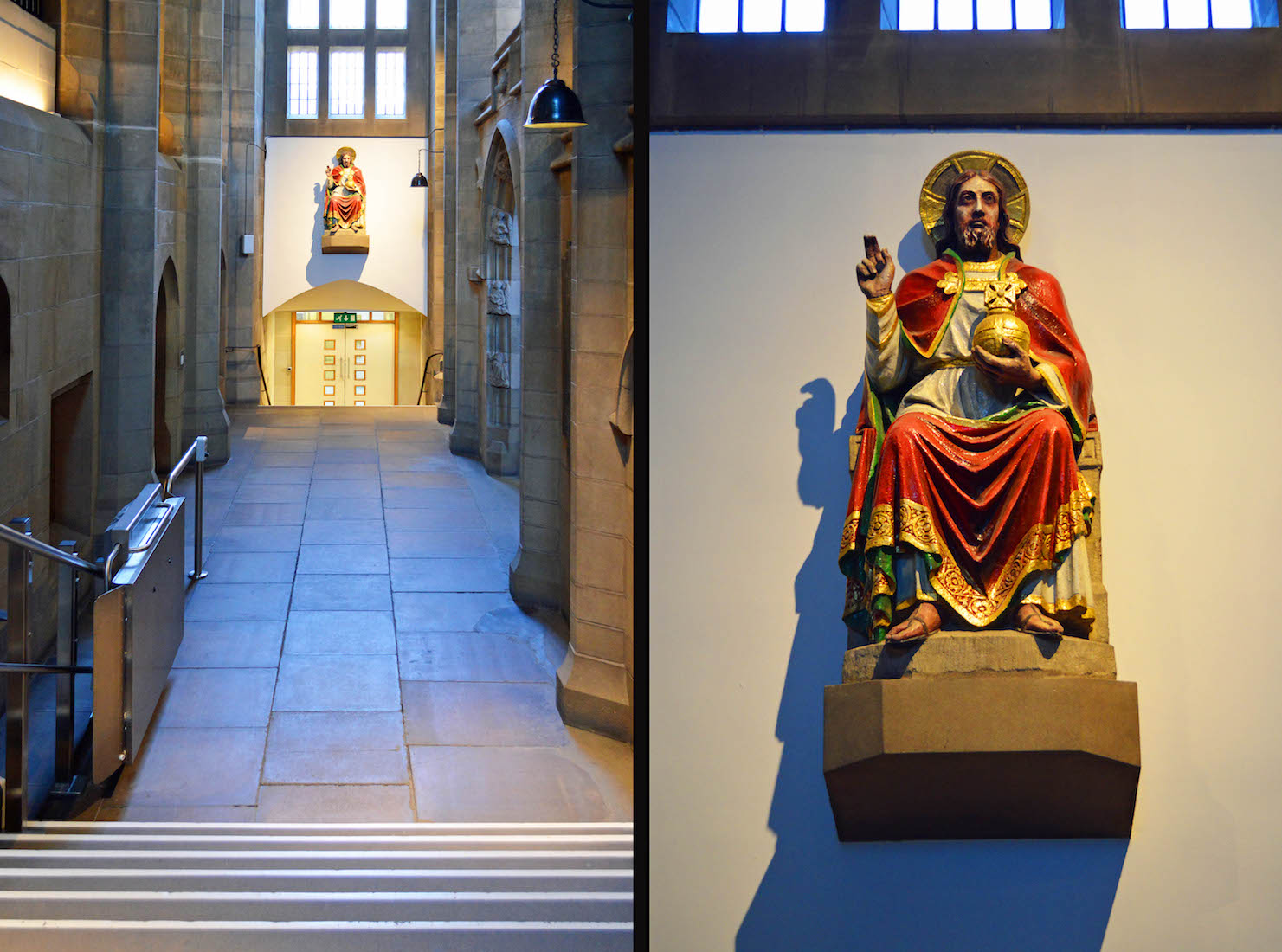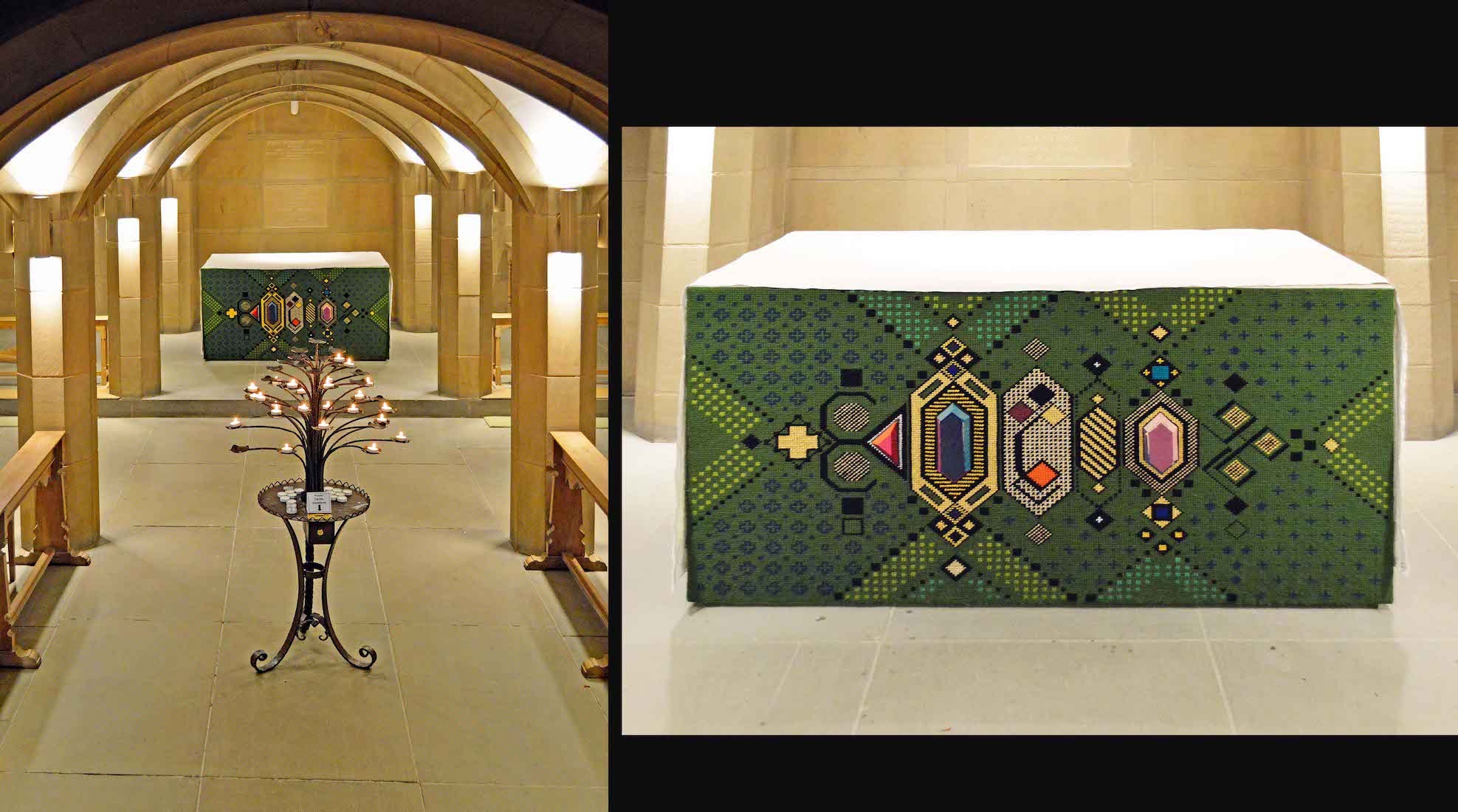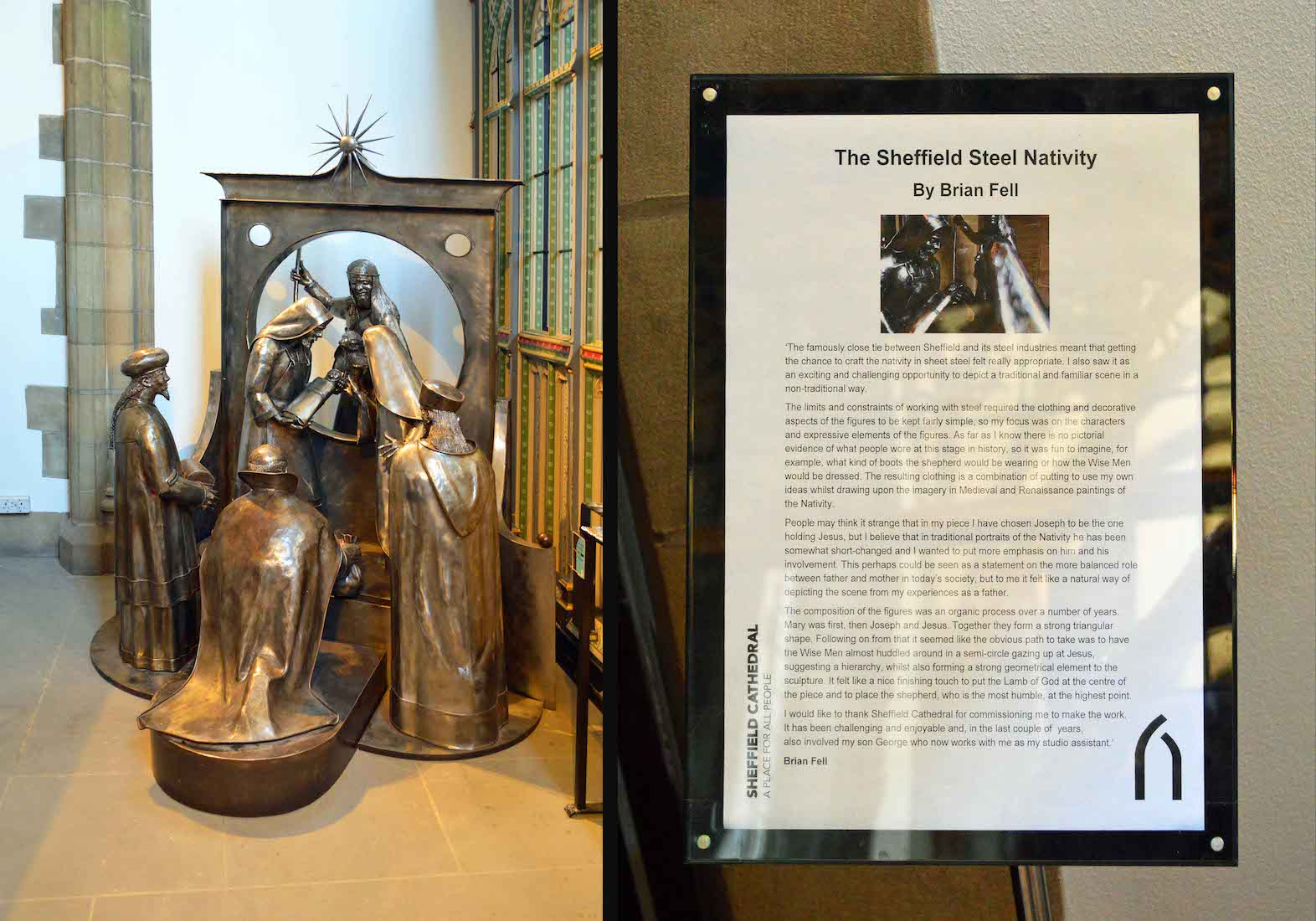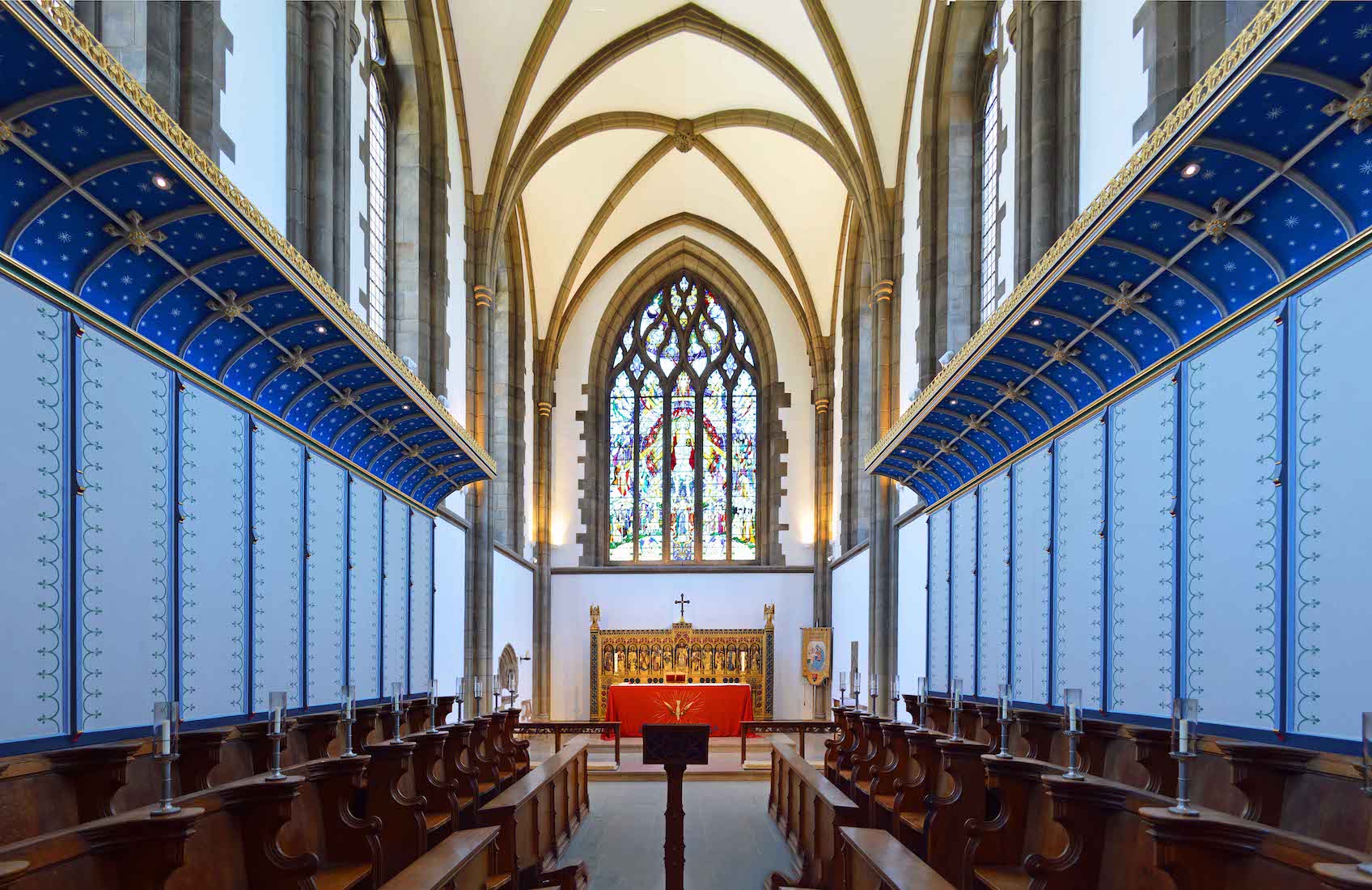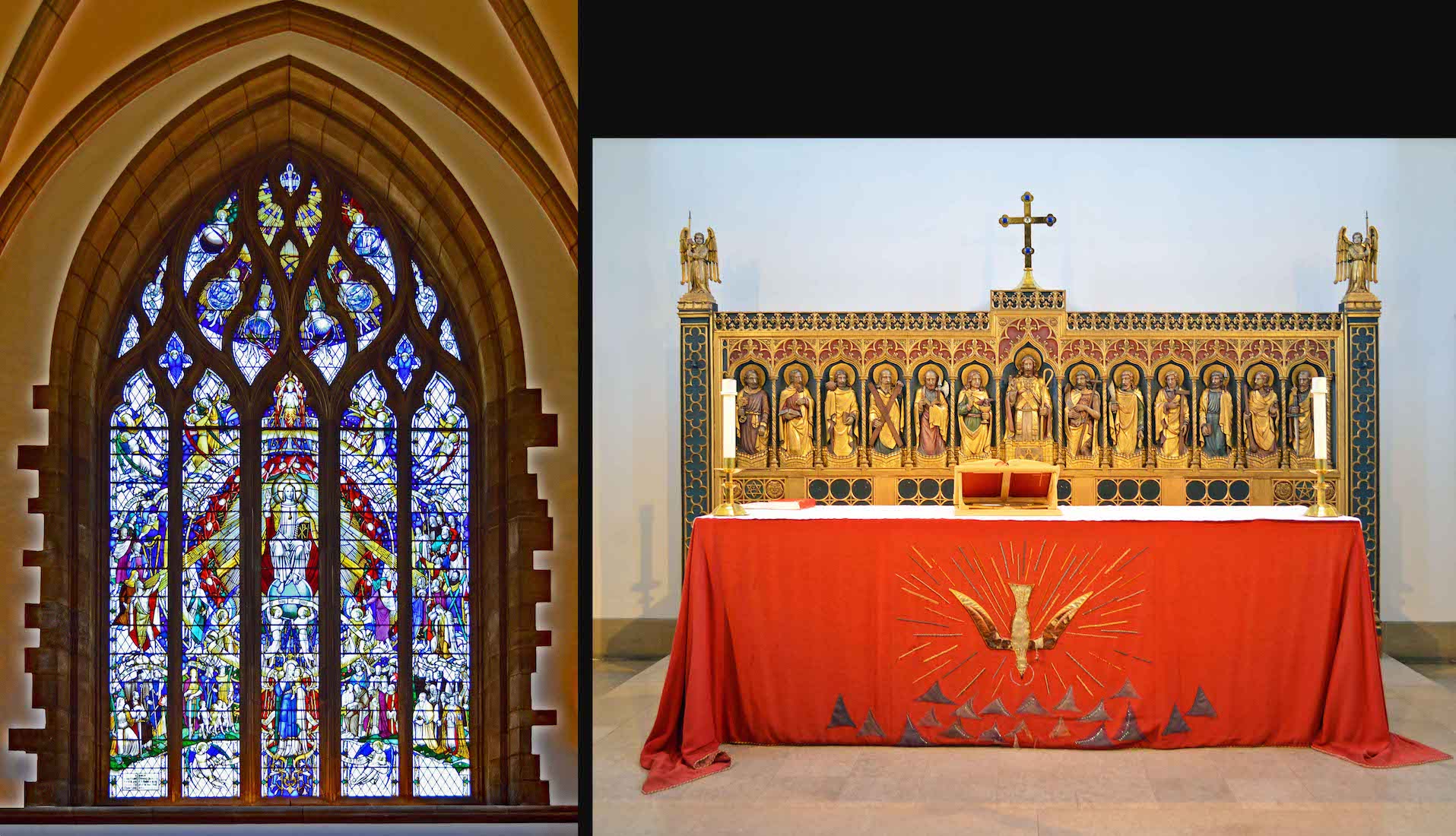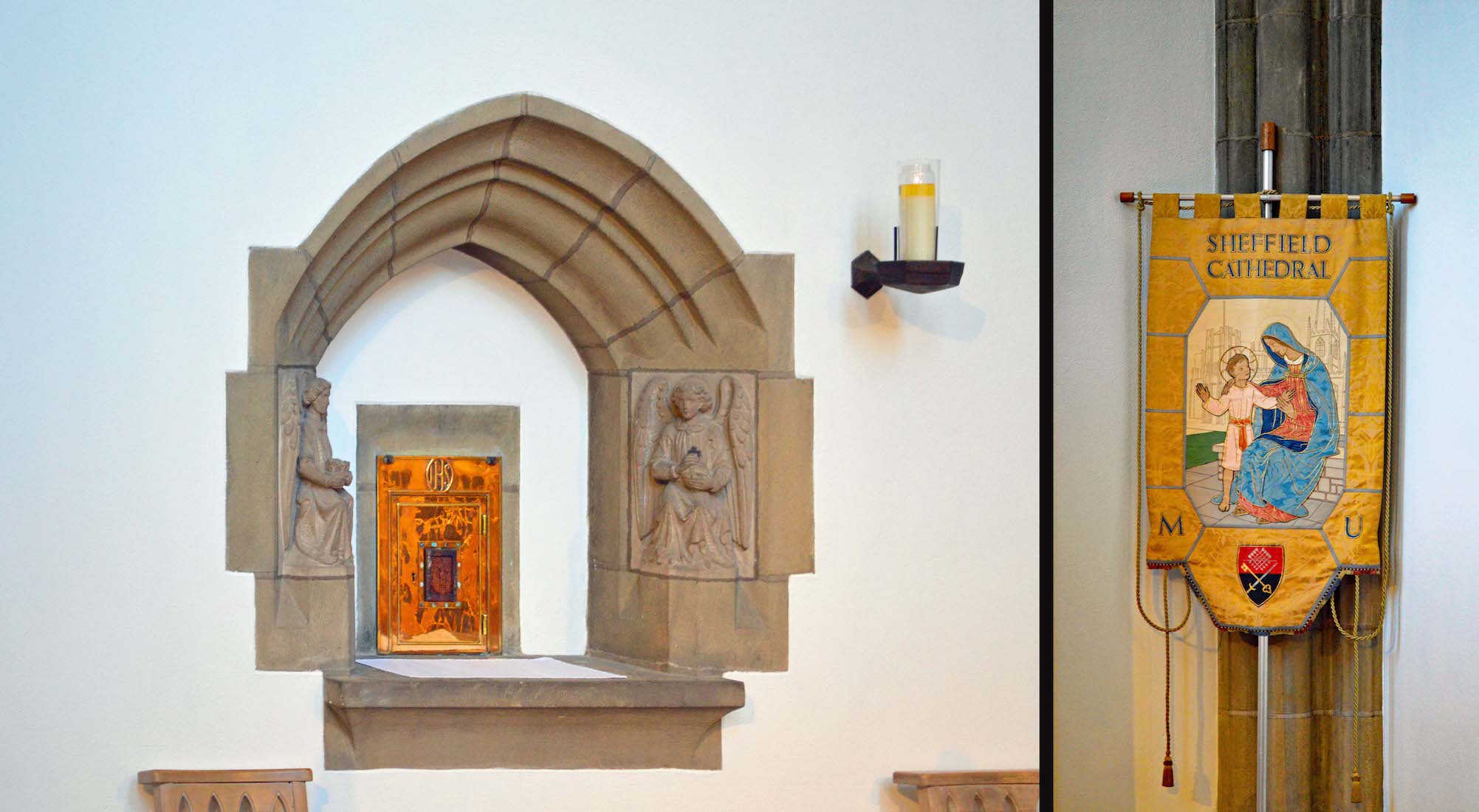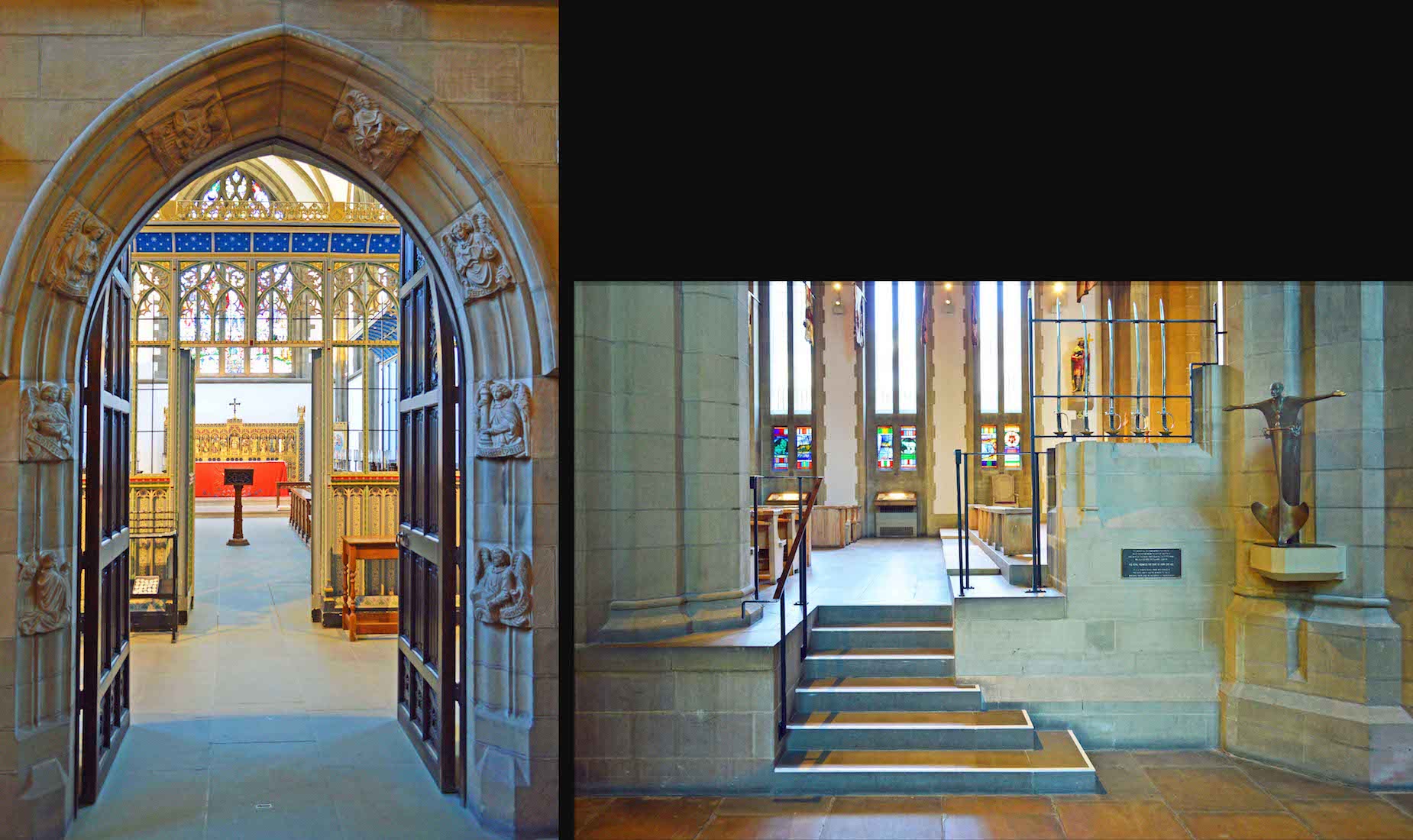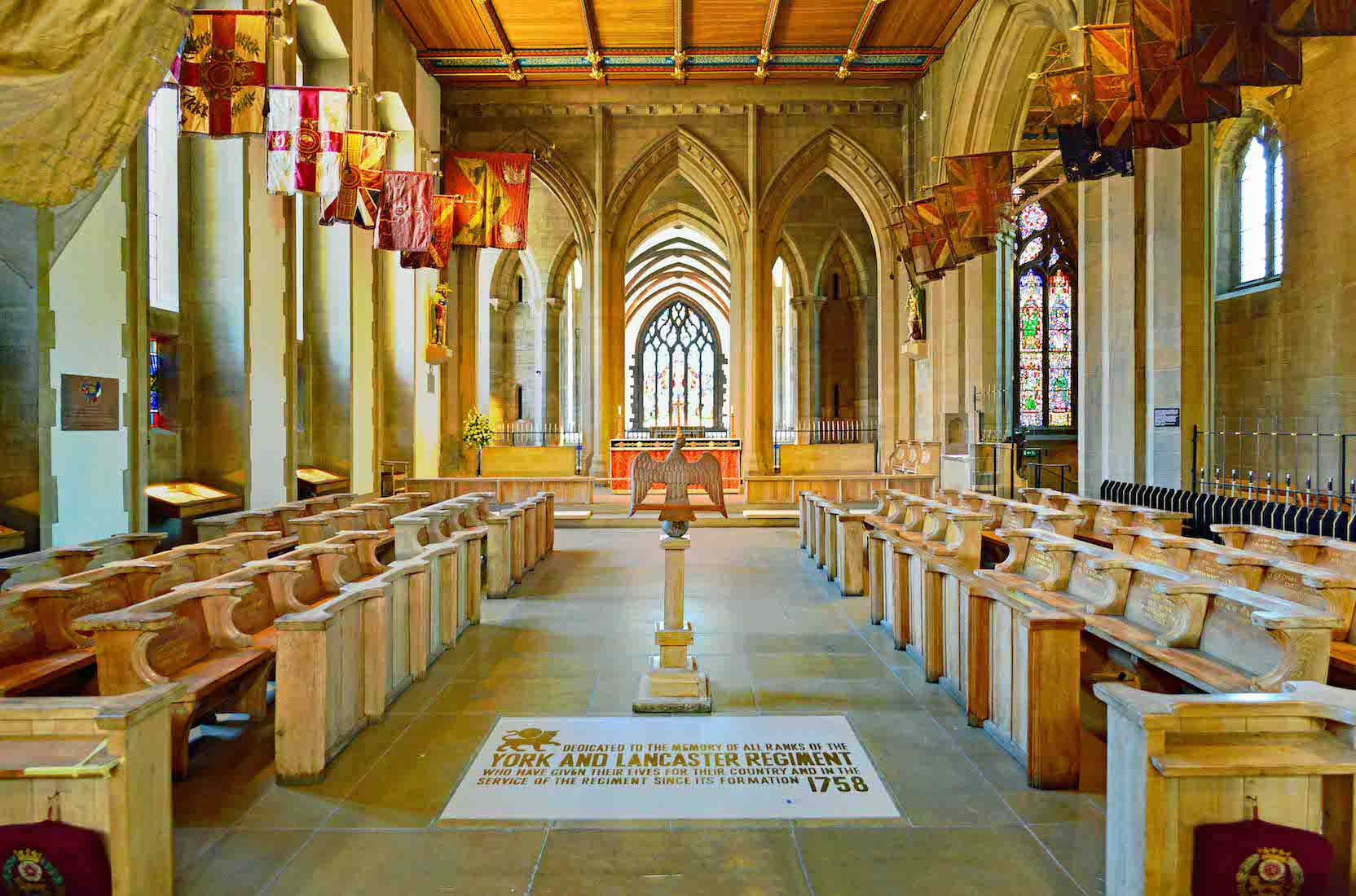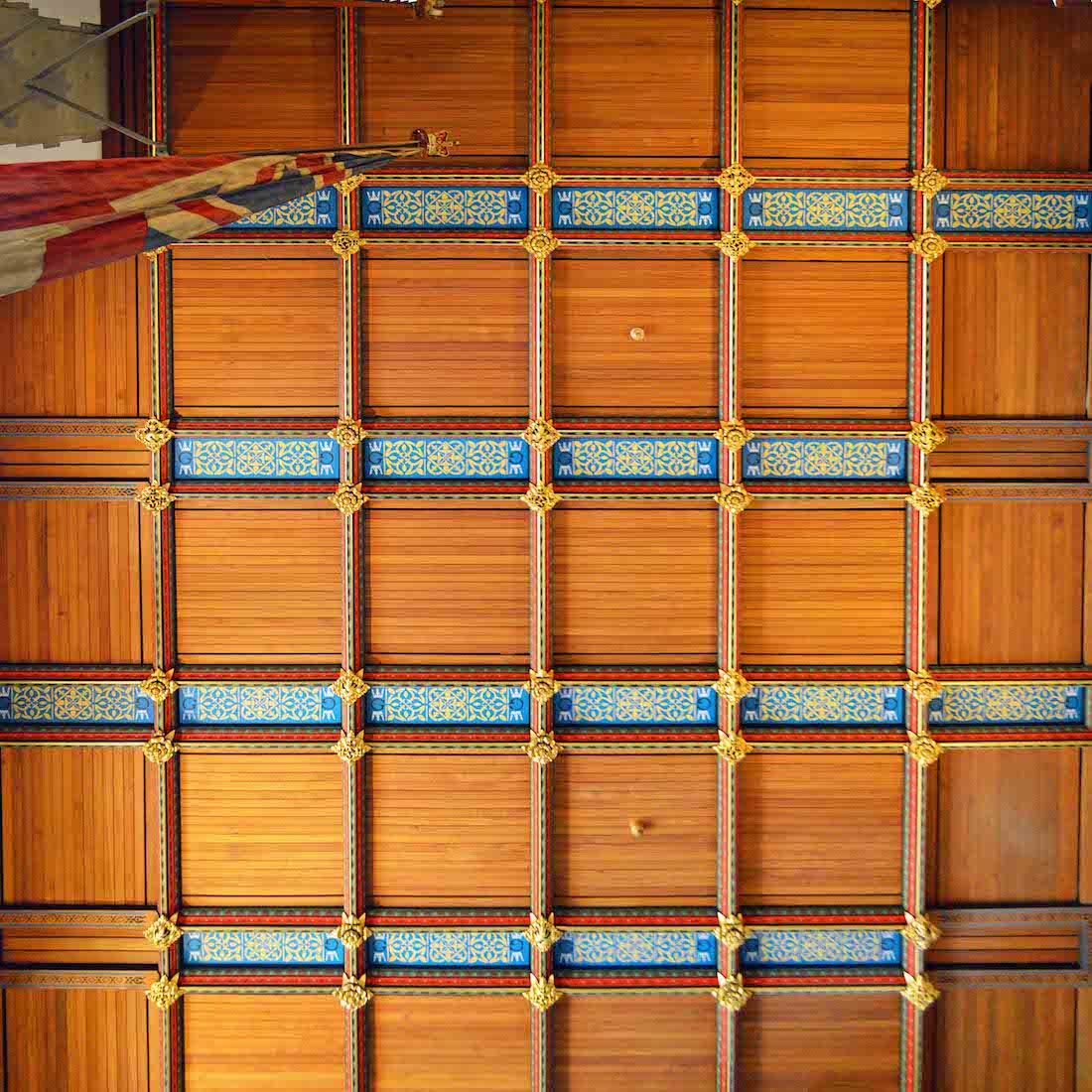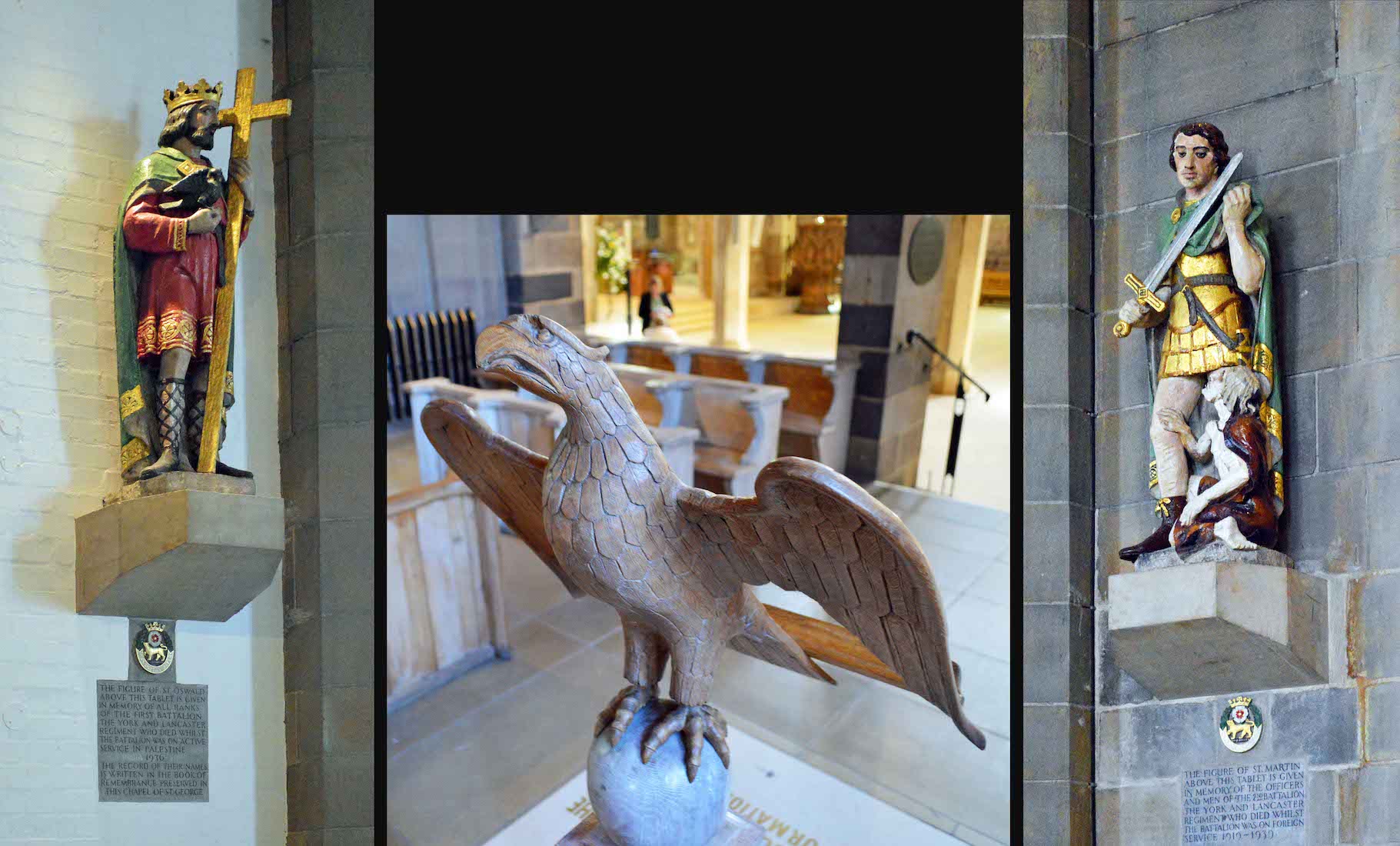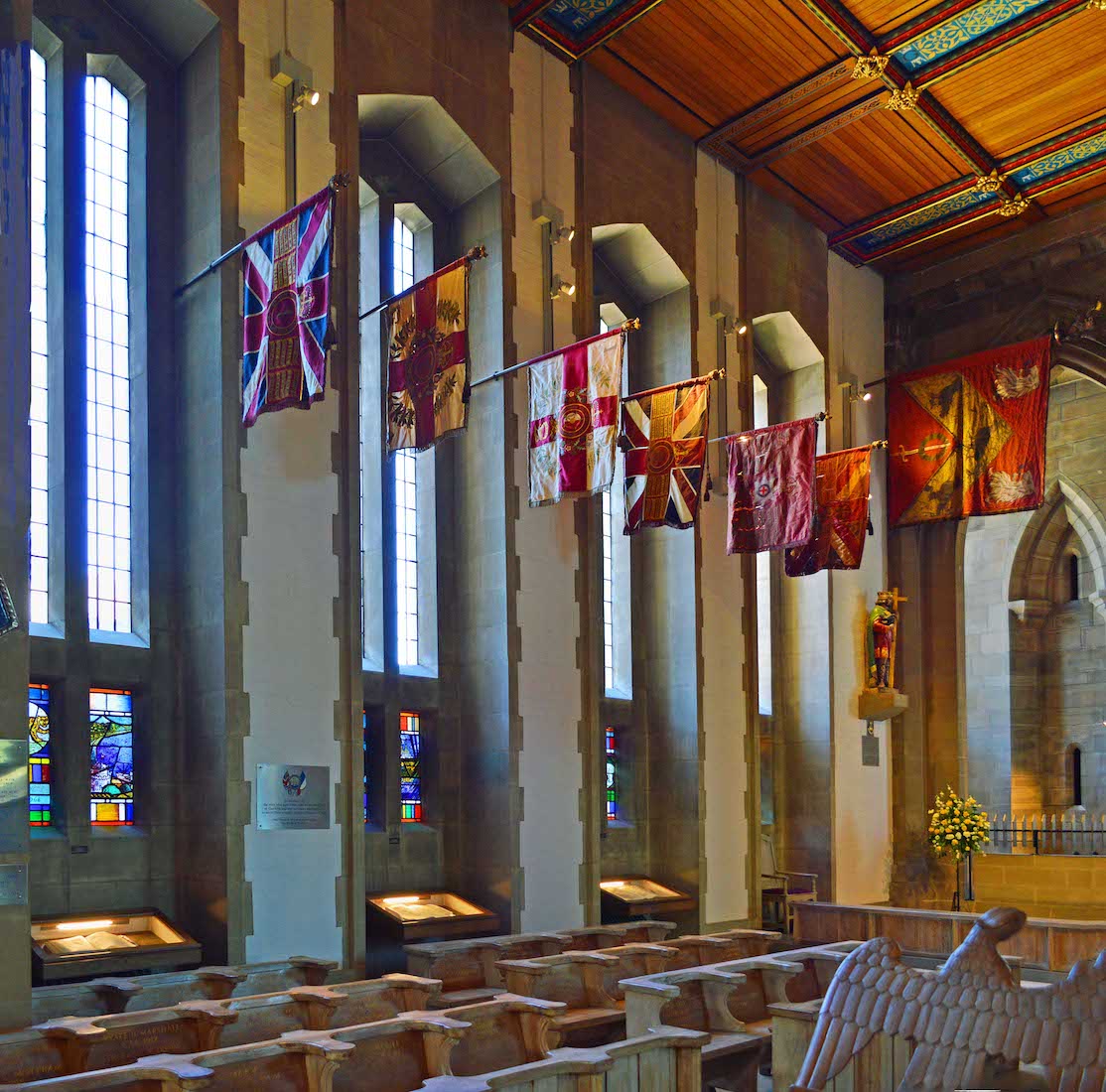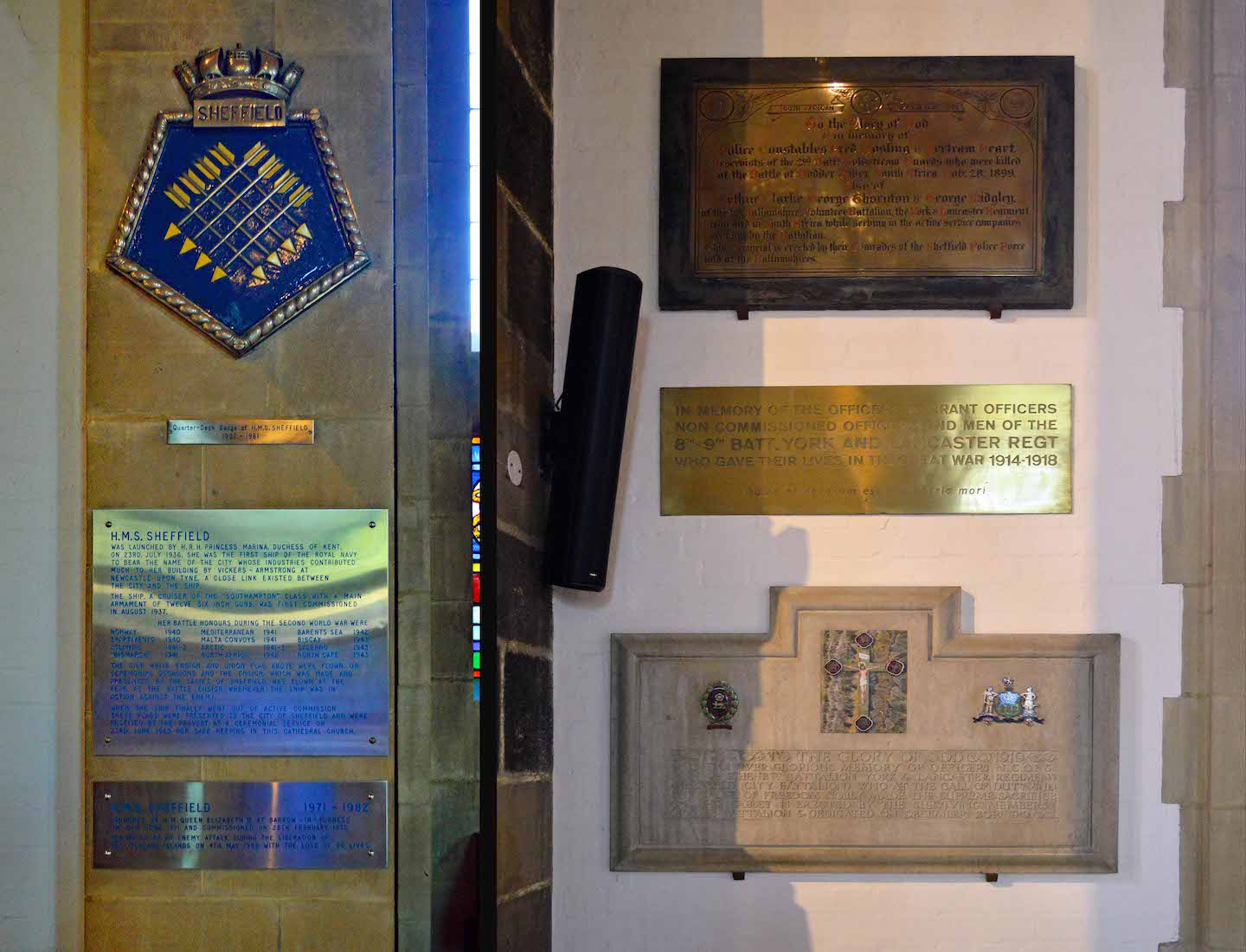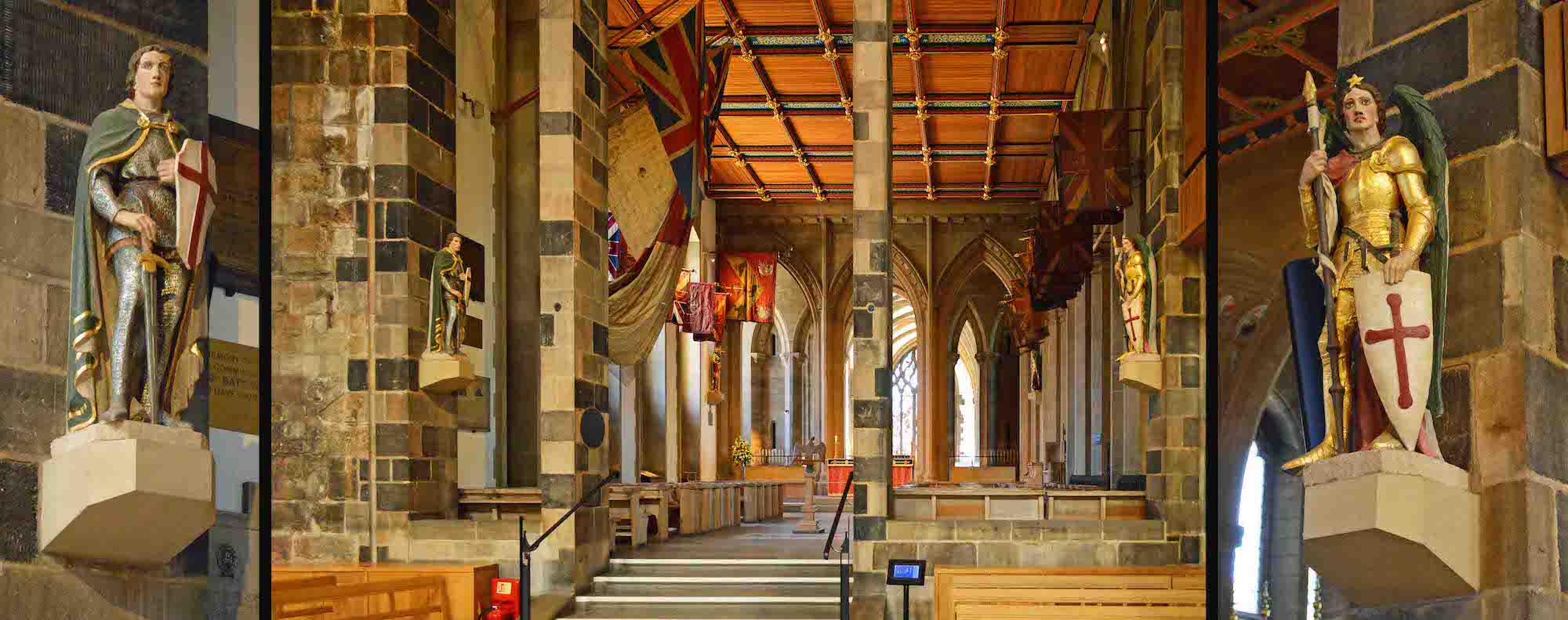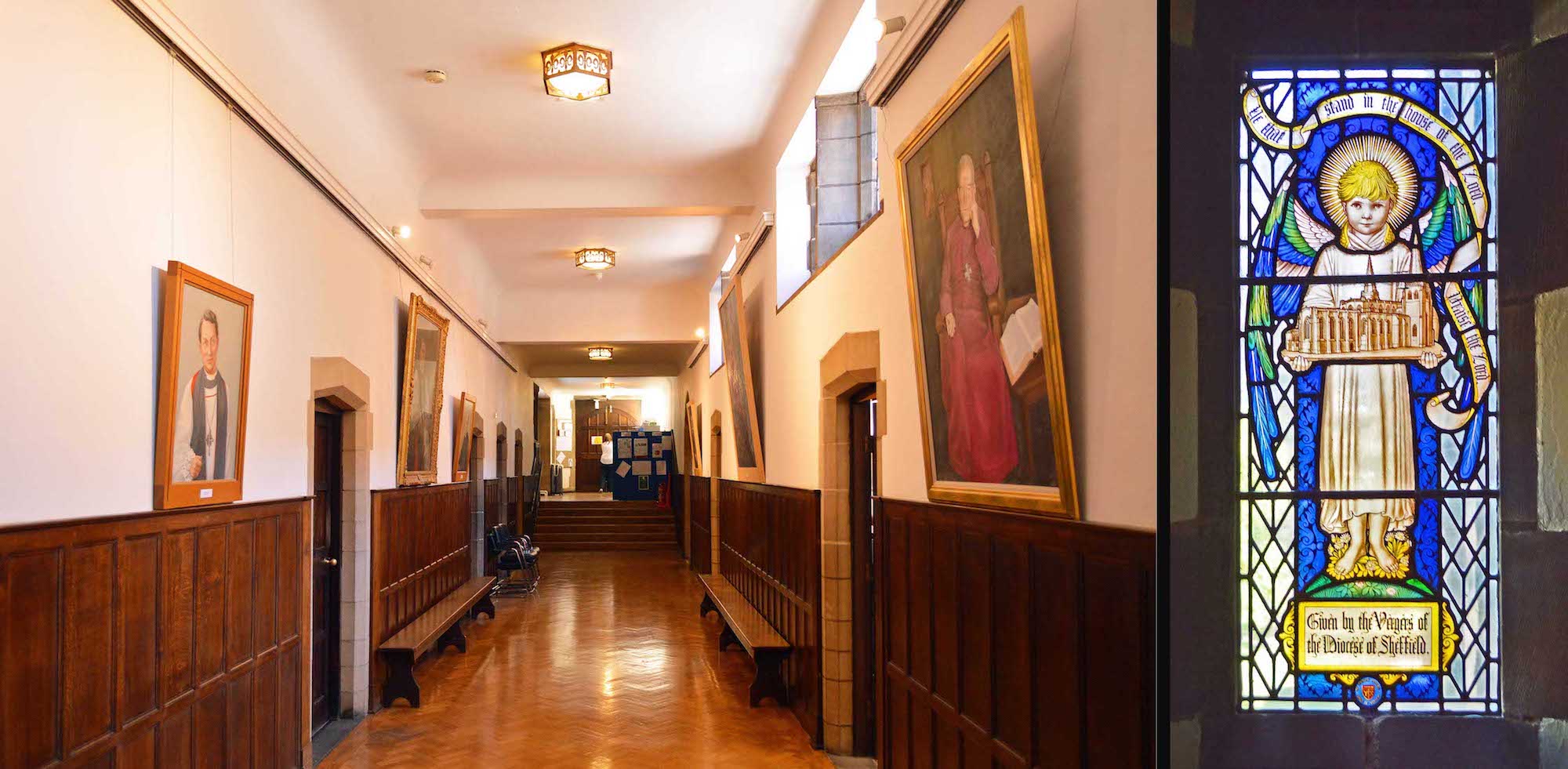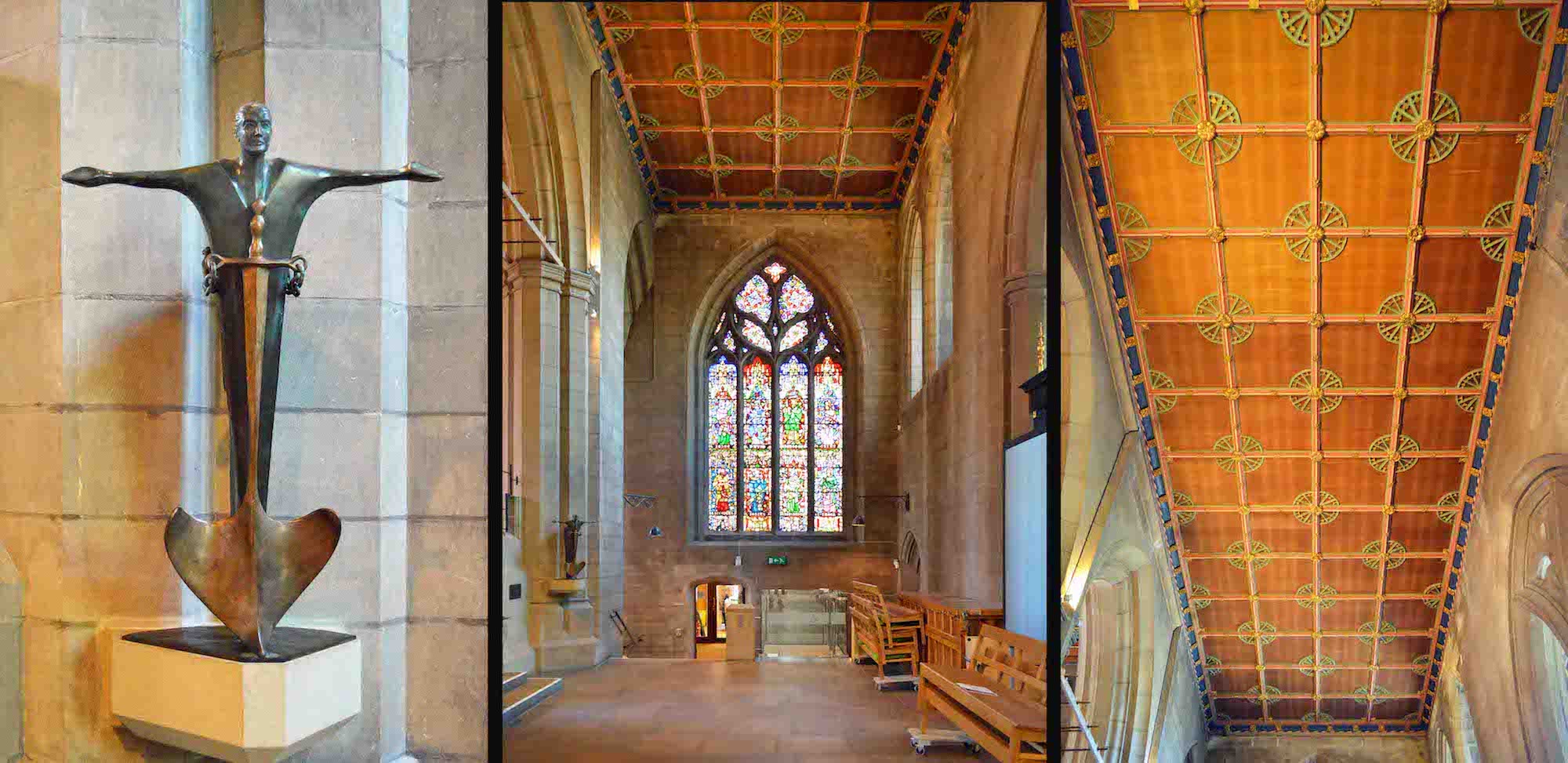
The original North transept is occupied by the Old St George’s Chapel. This adjoining space separates the old St George’s Chapel from the (new) St George’s Chapel. It leads to the Crypt Chapel and the Chapel of the Holy Spirit. The bronze anchor memorial by Stephen Broadbent, is dedicated to the special relationship between the York and Lancaster Regiment, the City of Sheffield and the ships of the Royal Navy which have borne the city’s name. It was placed in the Cathedral in 2000.. PLAN
62. NORTH TRANSEPT WINDOW

The stained glass window at the North end of the Burrows Transept is the Tree of Jesse Window by Henry & Alfred Gerente, dating from 1853. It was installed 1946, and was formerly in St Luke’s, Hollis Croft, since demolished. A Jesse Window traces Christ‘s family tree from Jesse, the father of King David, through the Kings of Israel to Jesus.
63. DOWN TOWARDS THE CRYPT
Steps from the end of the Burrows Transept lead to a short East-West passage which gives access to the Crypt Chapel. At the end of the passage is a figure of Christ in glory, holding an orb. The doorway through to the Chapel of the Holy Spirit can be seen at right.
64. DOWN TO THE CRYPT CHAPEL
The Crypt Chapel is a small chapel dedicated to All Saints situated underneath St George’s Chapel, and is constructed with arches and vaulting, making this an intimate and peaceful place for prayer and contemplation. The Crypt Chapel is the first purpose-built chapel in an English Cathedral for the storage of ashes, and the names engraved in the stone walls include some of the most significant people in the Cathedral and city’s history.
65. CRYPT WINDOW AND ICON
Tucked away in the far corner of the Chapel is a unique window by Keith New, created in 1966 in memory of Rowley Hill who was Vicar of Sheffield from 1873 to 1877. Its design is inspired by a vision of the Heavenly city with its twelve pearl gates represented by twelve pearly mosaic circles and the ‘glory of light’ being created by hundreds of tiny coloured perspex tubes creating jewel colours through which light enters the chapel. The icon shows Mary with Jesus after the Crucifixion.
66. STEEL NATIVITY
In the corner of the Crypt Chapel is the Steel Nativity sculpture. Sheffield Cathedral commissioned the artist, Brian Fell, to create a nativity scene from sheet steel. The medium is particulalrly appropriate, considering the city’s production of steel. The sculpture shows Joseph holding the baby Jesus, the sculptor feeling that Joseph has often been ‘short-changed’ in the Nativity story.
67. CHAPEL OF THE HOLY SPIRIT
Part of the 1930s extension and planned to be the new Lady Chapel of the reoriented Cathedral, the Chapel of the Holy Spirit is dominated by the great Te Deum stained glass window by Christopher Webb. This majestic window is a beautiful and awesome representation of God’s work on earth. The wooden stalls and the canopies over them were designed by Sir Ninian Comper.
68. CHAPEL WINDOW AND ALTAR
At the top of the Te Deum window is a dove whilst at its centre is Christ in Glory surrounded by prophets, martyrs and the faithful through the ages. The rich colours and beautiful detailed figures are characteristic of Webb. Below the window is the altar and behind it is a reredos depicting Christ and the twelve disiples – which was given to the Cathedral by the Freemasons of Sheffield after the First World War in memory of those who gave their lives.
69. CHAPEL AUMBRY, BANNER
To the left of the altar is a golden-faced aumbry guarded by two angels. To the right is the banner of the Mothers’ Union of the Cathedral. The design of the Chapel was inspired by the 700 year old Lady Chapel at Llandaff Cathedral, Wales..
70. MOVING TO ST GEORGE’S CHAPEL
We now leave the Chapel of the Holy Spirit through the decorative entry arches, and make our way back to the side entrance to the St George’s Chapel, next to the Sheffield anchor.
71. ST GEORGE’S CHAPEL
St George’s Chapel was originally planned to be the new Sanctuary of the enlarged and reoriented Cathedral as planned by architect Sir George Nicholson in the 1930s but is now the Memorial Chapel dedicated to the York and Lancaster Regiment which formed in 1758 and disbanded in 1968. Various regimental colours hang on either side, and the view to the North looks out through the lower Chapel of the Holy Spirit.
72. ST GEORGE’S CHAPEL CEILING
The timber ceiling has attractive coloured strips and golden bosses. This Chapel holds many memorials to those who lost their lives in conflict. The wooden stalls (seats) are carved in memory of some members of the Regiment and beneath the stained glass windows are three cases containing ‘Roll of Honour’ books of the York and Lancaster Regiment from 1914 to 1968. Not pictured are hand-embroidered kneelers before the altar which bear the crest of the Regiment; these were made by the ladies of the Regiment.
73. ST OSWALD, EAGLE, ST MARTIN
Statues of St Oswald and St Martin look down from either side of the altar, and the central lectern is in the form of a carved wooden eagle. Oswald (c 604 – 641/642) was King of Northumbria from 634 until his death, and is venerated as a saint. Saint Martin of Tours (316 or 336 – 397) was a military man who became the third bishop of Tours. He has become one of the most familiar and recognizable Christian saints in Western tradition.
74. CHAPEL ALTAR AND SCREEN
At the East side of the Chapel is the unique Screen of Swords and Bayonets which was presented to the Cathedral by the York and Lancaster Regiment after its disbandment, in memory of those who gave their lives whilst serving with the Regiment. The swords which point upwards signify readiness to serve whilst the bayonets pointing downwards represent the laying aside of weapons. [Photo Credit: Wikipedia]
75. CHAPEL COLOURS
The large white ensign (flag) was made by the women of Sheffield for the first HMS Sheffield which saw action in World War II. The other flags are the Regimental Colours of the York and Lancaster Regiment which were awarded to the regiment during the 19th and 20th centuries and which commemorate campaigns in which the regiment served.
76. CHAPEL MEMORIALS
The Chapel contains a number of memorials relating to various conflicts. There is a vertical panel relating to HMS Sheffield. And other tablets for the Police Constabulary, and the Regiment of York and Lancaster.
77. CHAPEL WINDOW PANELS
To the West of the Chapel are stained glass windows by Keith New which depict important episodes in the history of the Regiment. One window shows decorations awarded to members of the Regiment such as the Victoria Cross, the Distinguished Service Order, the Distinguished Conduct Medal, the Military Cross and the Military Medal together with their coloured ribbons. The remaining windows have reference to four other important campaigns.
78. LEAVING ST GEORGE’S CHAPEL
We leave St George’s Chapel by the main entrance from the nave. What a grand chapel this is! St George and St Michael look down from either side of the steps. St Michael and St George are regarded as military saints, and there is in fact a British order of chivalry called The Most Distinguished Order of Saint Michael and Saint George.
79. PROCESSIONAL CORRIDOR TO CHAPTER HOUSE
To the East of the Old St George’s Chapel is this Processional Corridor leading to the Chapter House. This area is not normally accessible to the public, but I befriended a Cathedral welcomer! A highlight of the Corridor is this little window given by the Vergers of the Diocese of Sheffield. It shows a delightful little cherub holding a model of the Cathedral.
80. EAST CHAPTER HOUSE
The rectangular Chapter House was gifted to Sheffield Cathedral by Fanny Tozer, in memory of her parents, and was dedicated in 1939. On my visit the Chapter House was being used for a school activity. This is a view looking to the East. All the windows here are by Christopher Webb. The Chapter House is primarily designed for use of the Cathedral Chapter, its governing body, to use for meetings.
81. WEST CHAPTER HOUSE
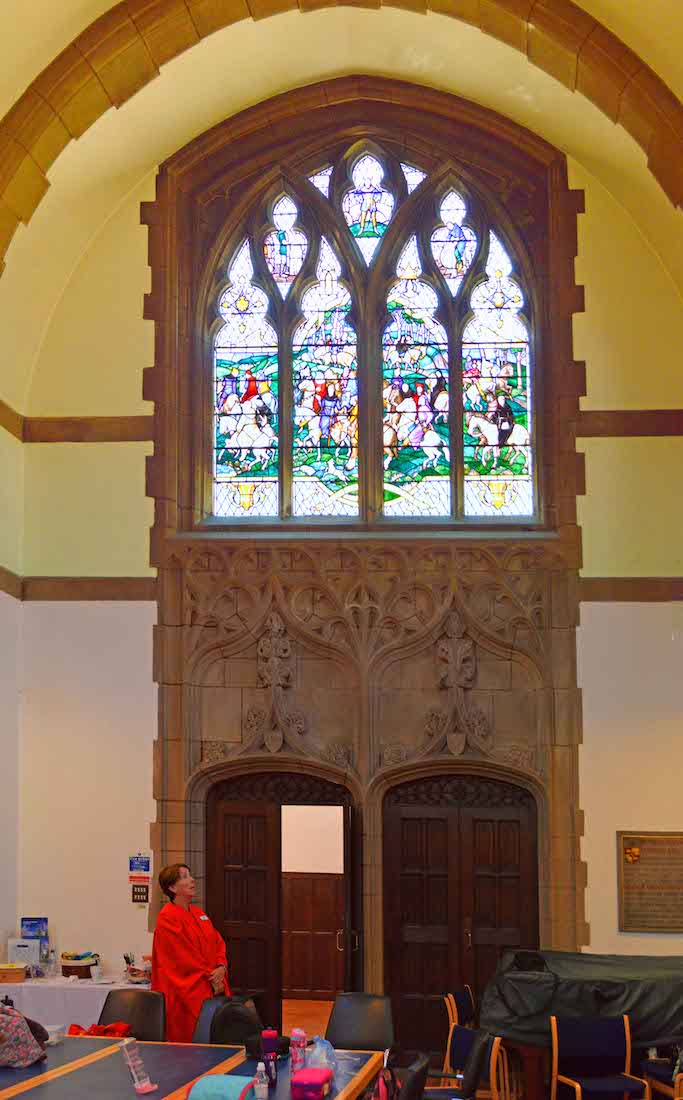
The larger window over the entrance door is probably one of the finest representations of Chaucer’s Canterbury Tales being related by the Reeve (the prominent figure in blue). This window gives the first mention of Sheffield cutlery in the Reeve’s tale: writing about the Miller he says ‘a Shefeld thwitel bare he in his house’ – he wears a Sheffield knife at his belt.
82. CHAPTER HOUSE WINDOWS

Inside the Chapter House we find six windows telling from left to right the story of Sheffield and its cathedral. Each window has two roundels each telling its own story all of which are skilfully described in the guide book. They bridge the years from the building of the Norman Church in 1101 to the Reformation period except that the roundels in the fifth window depict John Wesley preaching in Sheffield and the first bishop of Sheffield placing the Cross in his eightieth year (1938) on the north wall of the chapel of St. George. This completes our Cathedral tour.
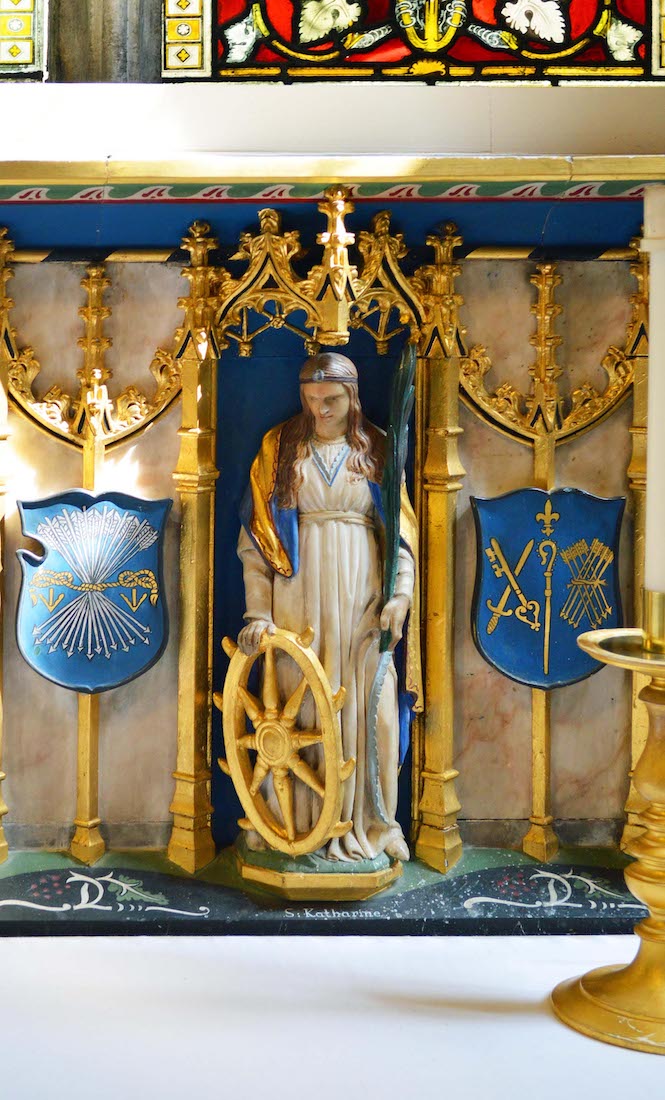
CONCLUSION
I hope you have enjoyed visiting Sheffield Cathedral with me. The lay-out is certainly unorthodox, but there are many points of interest, and a long history.
I am happy to receive constructive comments or corrections concerning this website. The best websites are the ones which have no errors! I am grateful to my wife Margie who has proof-read these pages.
With two exceptions, all the photographs on this site are mine, but the text has been drawn from various sources including the Cathedral Guidebook, Wikipedia, and the Cathedral website:
http://www.sheffieldcathedral.org/
My photographs which appear on this site can also be found in higher resolution at:
https://www.flickr.com/photos/paulscottinfo/sets/
Paul Scott Site created 12 / 2018 ; reformatted 05 / 2020.

